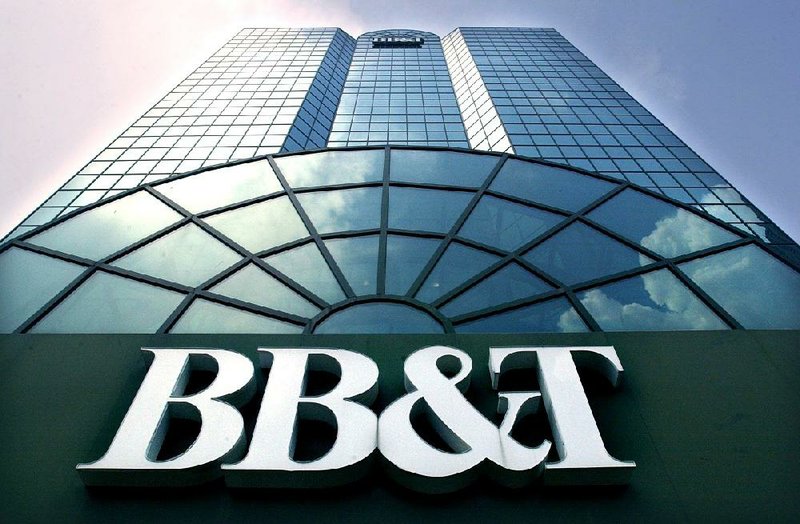Two large banks in the Southeastern United States announced Thursday that they plan to combine, in what would be the biggest bank merger since the 2008 financial crisis and would create the country's sixth-largest lender.
BB&T, in Winston-Salem, N.C., said it planned to buy SunTrust Banks in Atlanta for about $28 billion in stock. If the transaction is consummated, the merged banks, with $442 billion in assets, $301 billion in loans and $324 billion in deposits serving more than 10 million households.
The two banks' market share will make them a formidable presence in the South, particularly in growing parts of the country like Atlanta and Nashville, Tenn. The companies operate banks from Pennsylvania to Florida, and as far west as Texas. The only branch of the two banks in Arkansas is a SunTrust branch in West Memphis.
The new bank would be based in Charlotte, N.C., and operate under a new, as-yet-undisclosed name.
The combination of BB&T and SunTrust would create a Southeast juggernaut and allow the new institution to save money by shutting side-by-side bank branches and cutting overhead costs. Indeed, the banks are likely to shed deposits and branches in some cities to comply with federal regulations.
In general, bank mergers tend to benefit shareholders and executives, but they translate into lost jobs and reduced competition, which hurts customers through higher prices and worse terms for banking products and services.
BB&T and SunTrust executives insist that will not happen in this case because, while they plan to eliminate lots of jobs, they will plow the savings into technological innovations that will foster greater competition with the nation's largest banks.
Most bank mergers stopped after the financial crisis because the banks had to clean up their balance sheets, and the regulatory environment under President Barack Obama's administration made mergers more difficult.
Since that time, the gap between the size of the big Wall Street banks and the regional banks like BB&T, SunTrust, PNC Bank, Fifth-Third and others has only widened. The only bank with the size and scale of the new merged BB&T-SunTrust would be U.S. Bank of Minneapolis, which has a large presence in the Midwest and Rocky Mountains. But even U.S. Bank with $456 billion in assets is dwarfed by the next largest institution, Citigroup, which has more than $1.4 trillion in assets.
Now, though, President Donald Trump's administration and its appointees at the Federal Reserve Board have eased regulations and signaled a more relaxed approach with the country's biggest banks.
The industry will be closely watching how regulators react to the BB&T-SunTrust deal, analysts said.
"This will be a meaningful gauge of regulatory comfort with bank mergers," said Isaac Boltansky, policy research director for Compass Point, an investment bank. For the biggest banks, Boltansky said, "my sense is that there is still a regulatory hesitancy."
The deal would bring the combined bank's assets to well over the $250 billion threshold that, under the 2010 Dodd-Frank Act, mandates that lenders adhere to stricter capital requirements and closer regulatory scrutiny.
A 2018 law raised the threshold from $50 billion, which led to widespread predictions of a wave of regional bank mergers. (The country's biggest lenders, such as JPMorgan, would still face prohibitively high hurdles to striking big acquisitions, though big regional lenders like U.S. Bank and PNC Financial might be able to buy smaller assets.)
The new regulations helped give BB&T and SunTrust certainty about the regulatory environment. "You might expect that we wouldn't announce something like this without feeling confident" about the response from Washington, Kelly King, BB&T's chairman and chief executive, told analysts on Thursday.
The plan is already attracting attention from opponents of megabanks. Sen. Elizabeth Warren, a Massachusetts Democrat who is running for the 2020 Democratic presidential nomination, sent a letter to the Federal Reserve on Thursday expressing concerns about the deal.
She said data that the Fed provided her office last year showed that the central bank had rarely objected to proposed deals. It approved 89 percent of bank merger applications from 2014 through 2017, and 94 percent of applications during the first half of 2018. All were far smaller than the one proposed by BB&T and SunTrust.
A spokesman for the Fed said officials had received Warren's letter and were planning to respond.
Under the terms of the proposed transaction, BB&T would pay 1.295 of its shares, which were worth about $62.85 apiece at the end of trading on Wednesday, for each SunTrust share -- a 7 percent premium over SunTrust's Wednesday closing price.
BB&T would own 57 percent of the combined entity. While its headquarters would be in Charlotte, the new bank would maintain operations in Winston-Salem and Atlanta.
King of BB&T will become executive chairman of the merged bank, while William Rogers, his SunTrust counterpart, will be chief executive and will take over the chairman role in 2022.
"It's an extraordinarily attractive financial proposition that provides the scale needed to compete and win in the rapidly evolving world of financial services," King said in a statement. The deal is expected to close by the end of the year, pending regulatory and shareholder approval.
Information for this article was contributed by Michael J. de la Merced and Emily Flitter of The New York Times and by Ken Sweet of The Associated Press.
Business on 02/08/2019
